How GTM engineering can help you find what to read next — and some other surprising applications
Workbooks that find the best pizza, help you with salary negotiations, rate clothing sustainability, and more
We’re staring down the long Labor Day weekend here at Clay HQ and figured what better time to share some fun projects that our teammates have made using Clay. (Some are GTM engineers and some aren’t, which is part of what makes Clay such a unique tool for creative problem solvers.)
When most people think of Clay, they envision teams enriching lead data and automating outreach sequences. But data enrichment, AI processing, and automated decision-making can help do just about…anything. And that includes figuring out where to get a slice of pizza or how to find furniture dupes for any budget.
Here’s how different Clay employees are building tables for their own needs:
Goodreads wrapped: personalized book discovery
The ultimate NYC pizza finder
A “Severance” inspired employee onboarding experience
A salary negotiation assistant
Budget bougie furniture sourcer
The garment grader: fabric sustainability analyzer
A personalized NYC travel concierge
Find out how they built these plays below!
Goodreads wrapped: personalized book discovery
Claymate: Natalie Ho
Use case: Automating book recommendations and library availability checks
Link to Clay workbook
Natalie is on our CX team and built a “Spotify Wrapped, but for books” experience using Clay. Her project automates the discovery of new books to read based on past preferences, and checks local library availability—all without needing to manually browse Goodreads threads or catalog databases. The system:
Filters books rated >3 stars from her 2024 reading history
Uses Claygent to find similar titles via Apify, Goodreads, and Reddit
Checks local library availability using Navigator
Flags data mismatches and confidence issues for future improvement
The innovation: Natalie’s project showcases how AI agents and enrichment workflows can make even deeply personal decisions—like what to read next—more streamlined and intelligent. By combining multiple data sources, she built a recommendation engine tailored to both preference and access.
The takeaway: This framework could extend into any content recommendation problem—books, podcasts, learning materials—or power consumer-facing products that tailor experiences based on past behavior and real-world availability.
The ultimate NYC pizza finder
Claymate: Cameron Goldberg
Use case: Curated, AI-scored pizza recommendations across NYC using Clay and community reviews
Claybook
New to New York and on the hunt for the perfect slice, one of our GTM engineers Cameron built an intelligent restaurant filtering system that blends Google Maps data with internet wisdom to discover NYC’s best pizza joints. The workflow:
Pulled a complete list of NYC pizza restaurants using Clay’s Google Maps integration
Automatically filtered out all national chains (e.g., Pizza Hut, Domino’s, Papa John’s) using a custom formula
Used additional filters to exclude large franchise chains with over 50 U.S. locations
Built a Clay agent to scrape and summarize reviews from Reddit, Instagram, Yelp, TikTok, One Bite Reviews, and articles
Assigned each restaurant a custom 1–10 score, categorized the type of pizza (e.g., NY slice, Neapolitan), and explained the reasoning behind the rating
Filtered for only 7+ rated spots and created a color-coded Google Maps overlay for easy mobile access
The innovation: This project is a smart blend of structured and unstructured data—Clay doesn’t just fetch Google results, it synthesizes vibe-rich content from community-driven sources. It’s a great example of how AI-powered enrichment can surface insights traditional search can’t reach.
The takeaway: This could easily scale to restaurant curation platforms, local food newsletters, or niche food tourism tools. Whether you’re searching for the best croissant in Paris or tacos in LA, this project proves Clay can help you taste better with data.
A “Severance” inspired employee onboarding experience
Creator: Ian Cox
Use case: Automated new hire experience for Lumon Industries
Claybook
Clay product designer Ian fully automated the manual process of creating employee welcome materials. His system:
Pulls new hire data from LinkedIn profiles
Generates personalized employee ID badges with custom graphics
Creates AI-written welcome scripts using employee background information
Produces personalized audio greetings using 11Labs voice synthesis
Builds interactive welcome pages with embedded media
The Innovation: This is what creative automation at scale looks like. Clay's ability to orchestrate multiple AI services (GPT for scripting, 11Labs for audio, custom image generation APIs) demonstrates how operations teams can build Hollywood-level production workflows without engineering resources.
The takeway: What once required hours of manual design work per employee now happens automatically, creating a premium onboarding experience that can scale with your org’s growth.
A salary negotiation assistant
Creator: Izzy Kim
Use case: Offer Negotiation Assistant powered by market intelligence
Claybook
Izzy is on the Clay customer education team and created a comprehensive salary negotiation platform that rivals enterprise compensation tools. The system:
Analyzes job offers and identifies comparable companies using Clay's enrichment capabilities
Scrapes LinkedIn job postings to gather real-time market salary data
Uses ClayQL to calculate median compensation across similar roles and companies
Generates personalized negotiation scripts based on market research and offer details
Integrates with external web applications through webhooks for seamless user experience
The innovation: This demonstrates personal finance automation—using enterprise data tools for individual career advancement. The integration between Clay's data processing and external applications shows how Clay can power consumer-facing products.
Broader applications: This framework could extend to career coaching, job market analysis, or skills gap identification at organizational levels.
Budget bougie furniture sourcer
Creator: Jenny Gu
Use case: Affordable furniture shopping assistant powered by Clay
Claybook
Clay software engineer Jenny combined Clay with creative AI workflows to solve a personal (but very relatable) challenge: finding beautiful furniture without breaking the bank. Her system automates the process of identifying dream furniture and locating high-quality budget alternatives across secondhand marketplaces. The setup:
Extracts product features and style cues from “dream” furniture listings
Uses Clay to analyze and compare visual similarity across budget-friendly listings
Calculates AI-generated similarity scores to match listings with aesthetic goals
Uses Clay Navigator to check multiple sources (like Facebook Marketplace) for potential matches
Automates outreach to sellers of high-match items for easy follow-up
The innovation: Jenny’s project is an excellent example of personal automation: applying enterprise-grade enrichment and AI logic to solve everyday consumer problems. It’s both fun and functional, showcasing Clay’s flexibility beyond GTM use cases.
The takeaway: This system could be extended to price tracking, secondhand luxury shopping, sustainable consumption workflows—or even resale arbitrage. It’s a smart mix of data processing, visual intelligence, and personal taste.
The garment grader: fabric sustainability analyzer
Creator: Perrine Brouillet
Use case: Understanding and scoring fabric sustainability using AI and enrichment workflows
Claybook
Slack AI
At Clay, Slack becomes a live interface for internal GTM operations. Engineers use Slack AI to turn historical conversations, shared docs, and team knowledge into a searchable knowledge graph. Common use cases include helping reps query objection responses, surfacing enablement content in real time, or launching workflows (e.g., enriching a lead or checking deal stage) with natural language commands. Engineers configure retrieval systems and define guardrails to ensure precision.
Clay product designer Perrine tackled the complexity of evaluating garment sustainability by building a structured fabric grading system using Clay. Her goal was to make sense of environmental impact across materials, brands, and certifications. The system:
Generated a fabric database using GPT and Claygent to pull sustainability data on 40+ materials
Evaluated biodegradability, microplastic shedding, pros/cons, and assigned each fabric a sustainability score
Scraped product and brand URLs to identify fabric composition and certifications
Cross-referenced this data with her enriched fabric database to generate a final weighted sustainability score
Sent user input and scoring results between Slack and Clay via Zapier and webhook integrations
The innovation: Perrine turned a vague and subjective domain into a repeatable data-driven pipeline. By building a scoring engine powered by Claygent and cross-system orchestration, she gave sustainability-minded consumers and designers a powerful evaluation tool.
The takeaway: This model could power sustainable fashion platforms, B2B sourcing tools, or even governmental certifications. It’s a great example of using data automation to drive transparency in complex consumer decisions.
Personalized NYC travel concierge
Claymate: Luca Prando
Use case: Creating custom NYC itineraries using AI, Typeform, and Clay
Claybook
Luca is on our CX team and brought together multiple tools to create a delightful (and efficient) solution to a common traveler pain point—figuring out what to do in a massive city like New York. His Clay-powered travel concierge automates:
Typeform-based user input capture for preferences and travel context
GPT-powered generation of personalized activity recommendations, filtered by vibe tags
Lookup and enrichment of venues (restaurants, bars, museums, etc.) using Claygent and Google Maps
Email campaign automation using Clay’s sequencer to send custom itineraries
The innovation: Luca’s project is a seamless blend of enrichment, AI-driven content creation, and automated outreach. It shows how Clay can personalize customer experiences at scale with zero engineering help.
The takeaway: This workflow could scale to city tourism boards, concierge services, or even real estate onboarding experiences. It’s a smart example of how to turn static data into delightful, dynamic user experiences.
Workflow orchestration beyond sales
These personal projects are all about intelligent workflow orchestration and show how creative you can get with Clay. If you break each of these into their component parts you start to see some valuable data strategies:
Data integration at scale: Every project combines multiple data sources (LinkedIn, job boards, company databases, user inputs) into unified workflows.
AI-native processing: Complex AI operations (content generation, analysis, scoring) are treated as simple building blocks in larger automation chains.
Real-time decision making: Systems make intelligent decisions based on enriched data, from compatibility scoring to salary benchmarking.
External system integration: Webhooks, APIs, and custom integrations connect Clay to specialized tools and consumer applications.
No-code complexity: Operations teams build sophisticated systems that would traditionally require significant engineering resources.
Even if you’re not looking for your next beach read or to find a new sofa, you can use these as inspiration for creative plays. Sometimes you can find GTM alpha in surprising places.
Big thanks to Luca, Jenny, Perrine, Izzy, Ian, Cameron, and Natalie for their creative thinking and sharing their projects.


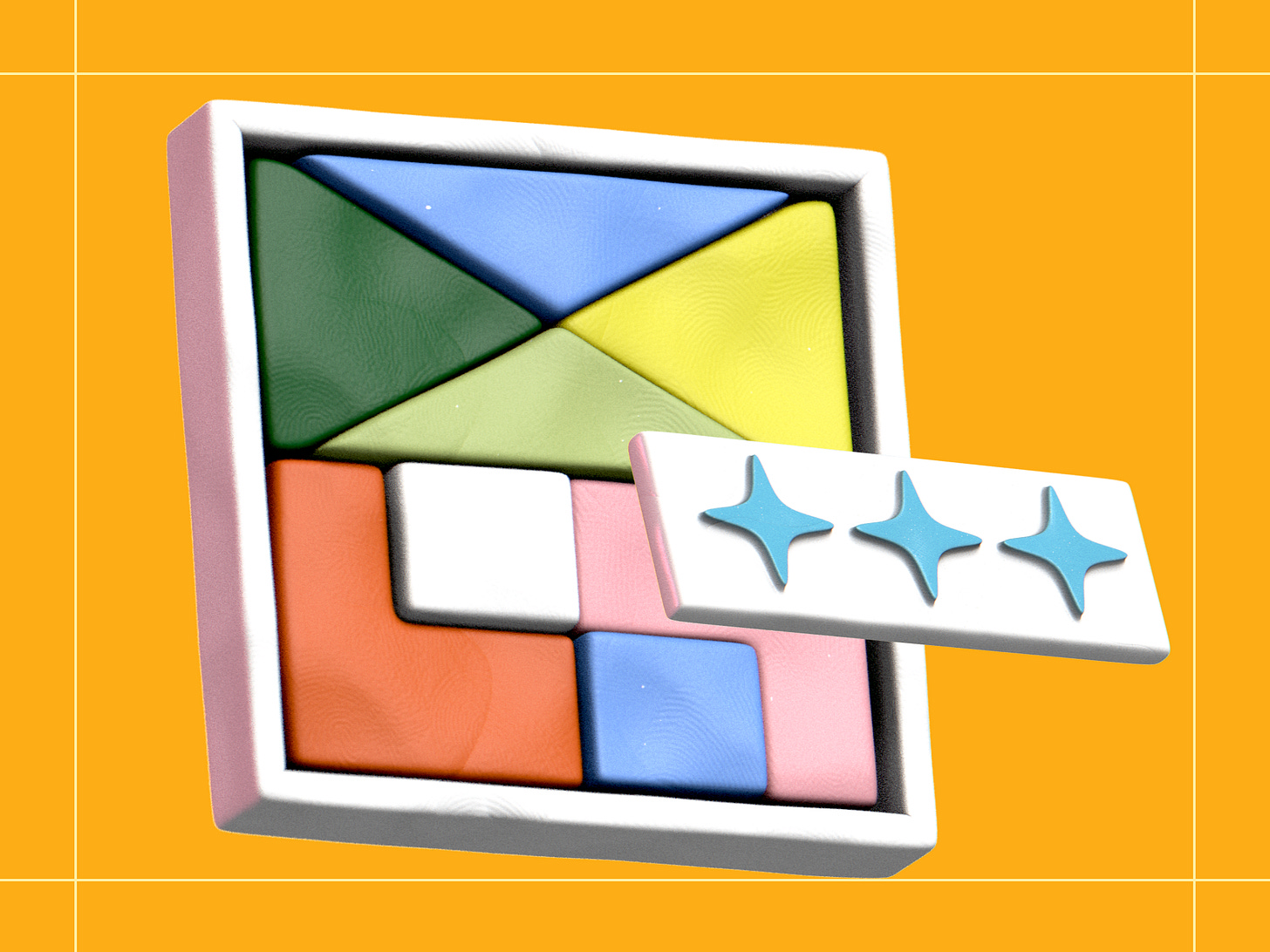
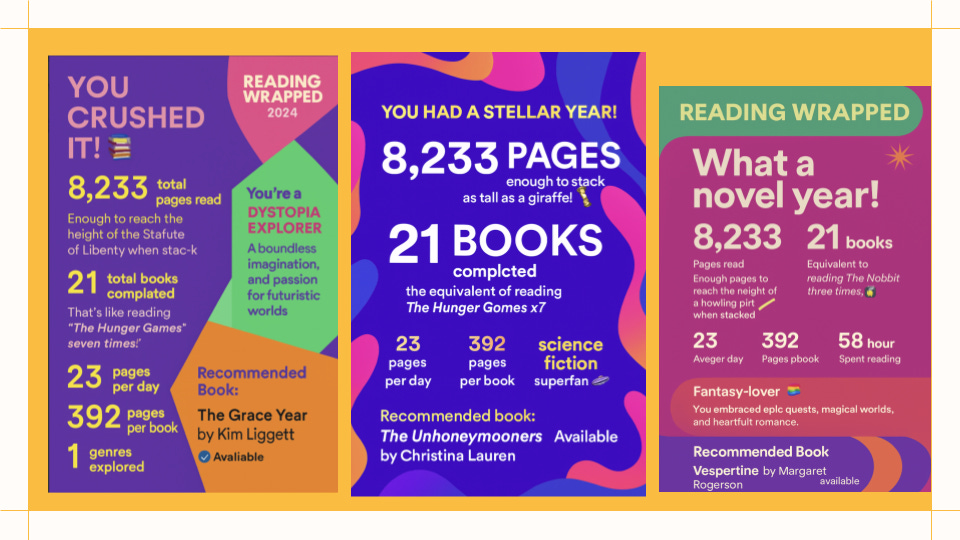
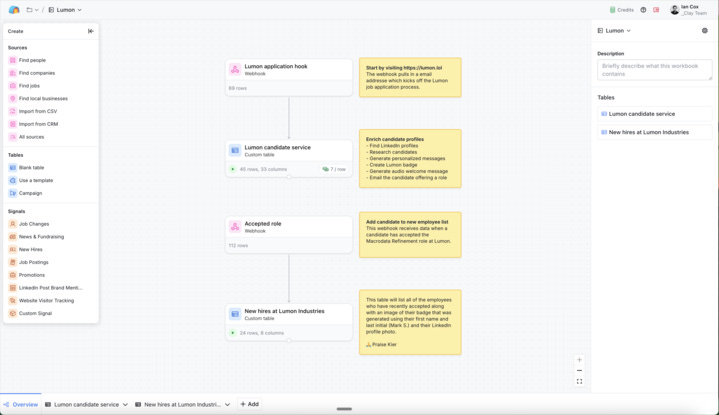
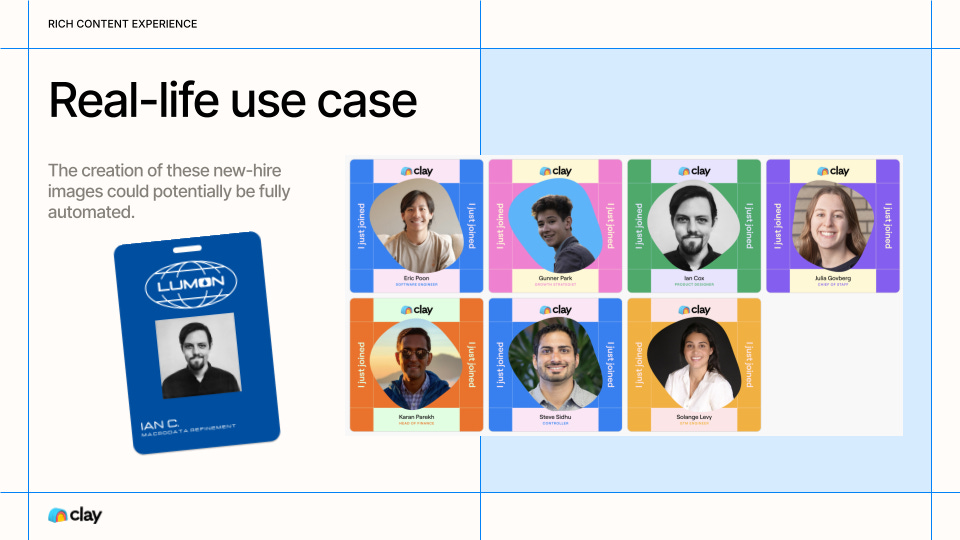
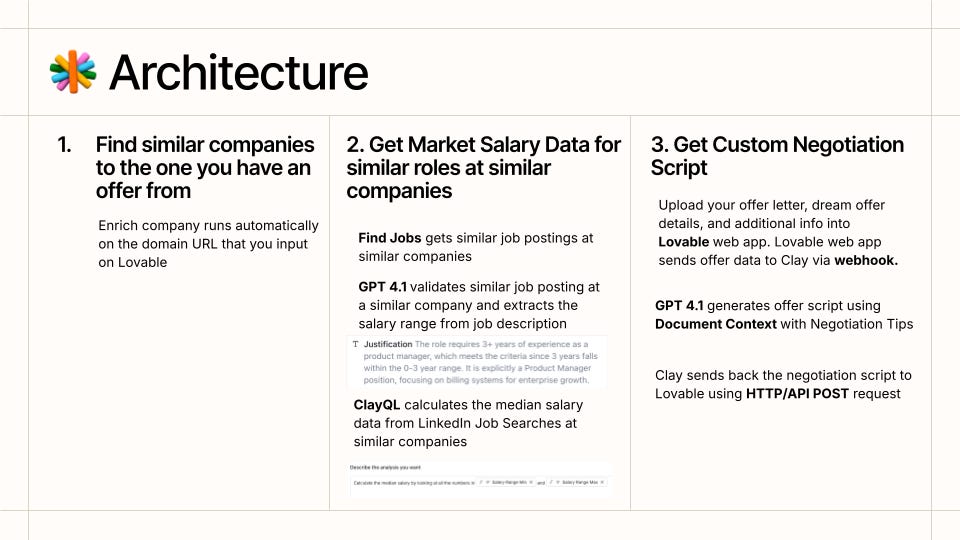
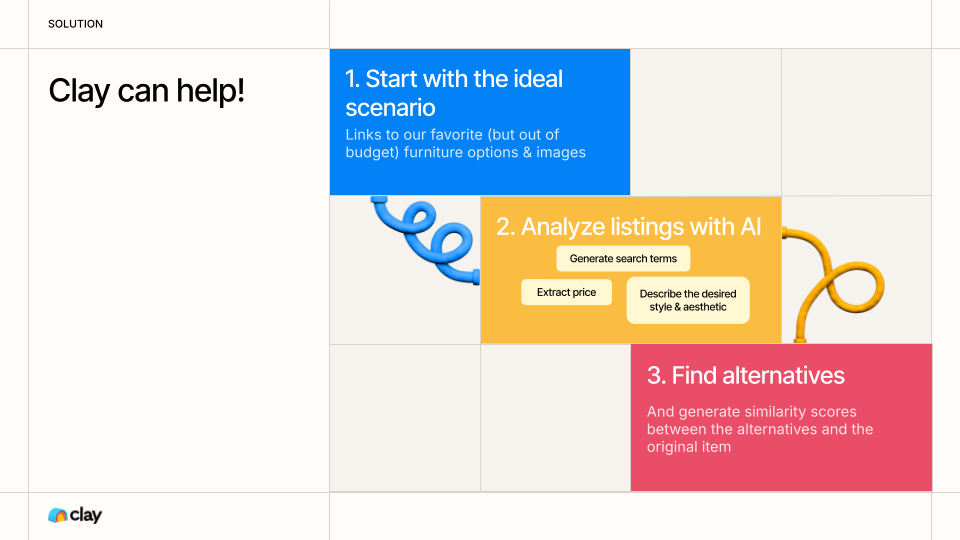

Only the first Claybook is an actual shared link!
One of my favorite non-traditional Clay use cases was finding YC startups to invest in, which was my Clay project during my work trial.
It was an experiment at first and then founders started replying and wanting to pitch.